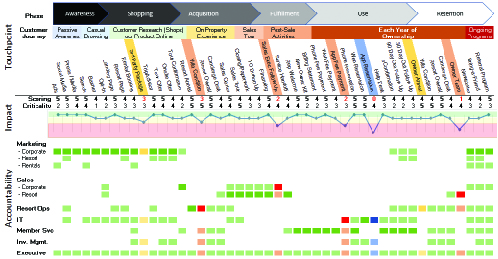Curating Your Brand Journey
As companies are returning to offices and board rooms, struggling to figure out what to work on first, this is a great time to take a strategic look at how and how well we engage our customers. Why? Quite simply, because most companies are leaving piles of money on the table by not assessing, understanding, and consciously curating their customer journey. Here’s a few statistics on the value of Customer Experience (CX) worth considering as you look to set your 2021 priorities:
• Customer-centric companies are, on average, 60% MORE PROFITABLE than their peer group.
• Customers with a good experience are 3.5X AS LIKELY TO REPURCHASE from a brand.
• US customers WILL PAY 17% MORE to buy from a company with a great reputation for service.
• CX is now a PRIMARY BASIS OF COMPETITION for more than two-thirds of companies.
The value in your brand is the sum of the current perceptions held by all your past, present, and potential customers. Their customer journey begins long before they first experience your physical product and extend much broader than the duration of their stay with you. From the first moment they hear about your brand, whether through an online ad, a friend’s social media posting of their last trip, or a newspaper article highlighting your stance on ecological responsibility or the unethical behavior of your executives during a recent conference in Thailand, every touchpoint throughout a customer’s unique journey will have some positive or negative impact on their perceptions surrounding your brand. Those perceptions, in turn, drive every aspect of your business… consideration, purchase intent, value perception, loyalty. Achieving and maintaining a strong, positive brand perception will literally make or break your business, but curating that customer journey is anything but random. While the customer journey varies by product and distribution channel, and even by discrete customer, you CAN have a significant impact on customer perception and drive results through a carefully crafted brand strategy throughout the continuum of your customer journey. Every brand leader must follow a consistent and iterative four-step process to achieve world-class customer experience across their unique customer journey:
- INVENTORY – Understand where and how customers interact with your brand.
- ASSESS – Quantify the current quality, sensitivity, and accountability for each touchpoint.
- PLAN – Build a prioritized plan based on the results of your quantified assessment.
- TRACK – Manage progress of the plan and ultimately verify improvement has been achieved.
The journey will continue to evolve as your product, business, and customers change, so it is important to periodically evaluate and update your journey map to reflect changing conditions, but a good journey map is relatively stable over a course of at least months if not years if your business is also relatively stable and consistent across those same timeframes. (SEE GRAPH BELOW Timeshare Brand Example)

INVENTORY
For any existing business, the first step in the process is to inventory all touchpoints your customers experience with your brand. That means ANY place and manner in which your brand is discussed, promoted, displayed, evaluated, used, or in other ways engaged by your existing or potential customers. (Note some practitioners will choose to discuss a customer’s journey as an isolated subset of experiences, and while that presents an easier way to concentrate on improvement of one aspect of your customer engagement, it ignores prior inputs and preconceived expectations.) A brand is also broader than just a physical product- that experience encompasses your physical products, but increasingly that brand focuses on your business practices and ethics, your leadership team, and the other products and services you choose to endorse consciously or unconsciously.
As you compile this inventory, also be sure to identify which person or department is accountable for ensuring customer perception of your brand is enhanced at this touchpoint. If there are multiple departments involved, note their respective involvement for now and we will come back to how to assign primary responsibility later.
ASSESS
Next you will want to complete an assessment for each touchpoint of the criticality, quality, and primary accountability for each touchpoint. At certain points in the ownership lifecycle, customer emotions are heightened, making those steps significantly more impactful than during times of lesser emotional significance. Typically, moments involving high stress, such as those involving financial decisions or physical tension (e.g. travel to an unfamiliar international destination) have the highest criticality. Both criticality and quality should be rated on a zero to five score for each touchpoint. You’ll want to look at the quality of the interaction, with a perfect score here meaning you’ve significantly improved the customer perception of your brand and a zero meaning you totally failed to meet your customer’s expectations at this step. While you’re assessing these two factors, you will also want to identify all involved departments and determine which has primary accountability for ensuring the best possible customer experience is consistently delivered at each step.
There are a broad number of tools available to help you properly quantify the scoring during this assessment. Be sure you are consistent, careful and unbiased in your scoring for this step or it will skew your results and planning later.
Performing a sensitivity analysis of your results will complete your baseline needed for action planning steps. Touchpoints of concern are those having either quality scores below a 3 or below their respective criticality scoring.
With this map laid out in front of you, now take the additional step of asking which touchpoints are misplaced or missing entirely. In other words, which touchpoints in your customer journey map would serve you better if p laced earlier or later in the process? Which existing touchpoints have you overlooked that you need to add back into your map? Which should be broken down into several sub-points (as with onsite experience at a resort, which might be 10-20 unique touchpoints, if you have the assessment and survey tools to evaluate things like satisfaction with your pool areas, golf course, spa, restaurants, etc.) Which opportunities have you missed entirely that you may want to commence to bolster your customer engagement levels at key points in the customer journey?
PLAN
Your completed assessment forms the basis for your action plan, identifying the areas of focus and departments accountable for leading the needed enhancements. Coordinating with these leaders to form one cohesive plan around these focus touchpoints will net you the best opportunity to see significant improvement across the entirety of the customer journey. Building in goals, timelines, and resource budgets for each focus touchpoint will give you a complete roadmap. As with any overarching corporate strategy, this plan should be vetted at senior levels and decisions made considering resource availability, anticipated financial and non-financial impacts, and other strategic priorities.
Since customer experience happens across many functional areas and possibly even across operating units of your business, it’s typically best to think of this as a project plan, with tasks, accountabilities, dependencies, milestones, deadlines, and goals. Leading implementation of that plan will typically require skills in both project management and political influence since project leadership is seldom the most senior executive in the organization or even the leader assigned most of the primary accountabilities to be addressed.
TRACK
A plan is useless until it is set in motion and progress is measured. Accordingly, that plan should be tracked through completion and periodic reassessment of quality should be undertaken. Doing so will assure that planned actions have anticipated and sufficient positive impacts or alternatively it may identify areas where incremental actions must be undertaken to deliver needed improvements to respective touchpoints.
SEE ACTION PLAN TRACKER BELOW
Timeshare Example (Continued)

This simplified tracker shows one of many templates for managing progress against your defined improvement plan. During this phase, project management principles are easily applied and use of both tools and leaders with project management competence will help deliver exceptional results.
Success, however, is never final. Once all customer touchpoints have reached target levels, continuous improvement approaches should be employed to ensure quality levels are retained throughout the customer journey and ongoing improvement is achieved.
As your business, distribution channels, and customer preferences evolve over time, these customer journey maps provide an important tool and baseline for your planning efforts, helping you to plan your rollout strategies and understand and measure the impacts of these changes.
SUMMARY
Understanding your brand’s unique customer journey (including all touchpoints, deficiencies, and accountabilities) provides a solid baseline for improving customer experience in meaningful and lasting ways. Executing plans utilizing proven project management philosophies and then going back to measure progress using continuous improvement principles will ensure that progress is achieved and extended as your organization, business, and brand continues to evolve and grow. While the number of touchpoints, involved leaders and functional teams, and associated complexity obviously scale with your distribution channel scope and organization complexity, these same strategies have been successfully applied to brands big and small with the same consistent results… more engaged and loyal customers who buy more, refer more, spend more, for longer, with your brand.
The author has focused on growth through innovation and customer experience for more than three decades and across a broad range of industries ranging from automotive to healthcare to hospitality. Today, as CEO of CX Artisans, Scott works with clients ranging from new healthcare startups to global blue-chip hospitality and technology leaders, helping each develop and execute more successful strategies for revenue and market share growth.
https://www.superoffice.com/blog/how-to-create-a-customer-centric-strategy/
https://experiencematters.blog/category/roi-of-customer-experience



